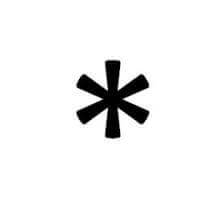The Asterisk (Trust Me About Grammar, Not About Baseball)
Today’s topic is the asterisk — Barry Bonds’s least favorite punctuation mark.
Mignon Fogarty
Listen
The Asterisk (Trust Me About Grammar, Not About Baseball)

Today’s topic is the asterisk.
Why? Because Barry Bonds just broke the record for number of home runs in one season* and people are talking about putting an asterisk next to his name in the record book because of the steroid controversy surrounding his career (1, 2). It’s a punctuation-related news story, and those come about so rarely I just couldn’t pass it up.
What Is an Asterisk?
The asterisk is that little star above the “8” key on your keyboard, and the word asterisk actually comes from the Latin and Greek words for “little star” (3). Asterisk can also be used as a verb to mean that you’ve marked something with the little star; for example, some sports writers want the baseball commissioner to asterisk Barry Bonds’s record.
I had a little bit of hesitation about doing this episode because the pronunciation is so tricky. It’s pronounced aste-risk. Aste-risk. It’s common to hear people call it aste-rick or aste-rix, but the correct pronunciation is aste-risk (4).
How to Use an Asterisk
My first rule for using an asterisk is to always make sure it refers to something at the bottom of the page. It makes me crazy when ads have an asterisk next to some offer, and then you can’t find what it means. More than once I’ve seen something such as Jack hammers, 20% off*, and then nothing else on the page to indicate what the asterisk means. Does it mean I get 20% off only if it is a Sunday and my name is Squiggly? I hate that!
That’s how an asterisk is used these days—you place it after something you want to comment on or qualify. Historically, asterisks were also used to show that something was omitted or that there was a passage of time, but that use has been largely taken over by the ellipsis (5). Today, the asterisk is for commenting, especially when you need to avoid letters or numbers.
For example, the Chicago Manual of Style wisely notes that when you add comments to mathematical or chemical equations, you should use symbols to keep people from confusing your comment marks as part of the equations. You wouldn’t want readers thinking your second comment note means to square the equation!
How to Use an Asterisk in Citations
They also note that if you have to include both citations and substantive comments in a document, you should use symbols for footnoted comments. You use the symbols in a specific order that starts with the asterisk and then continues with the dagger, double dagger, section mark, parallels, and number sign. If you need more symbols, you start over in the sequence and double each symbol; for example, double asterisk, double dagger, double double dagger, etcetera (6).
I couldn’t find anything to back this up, but I have a theory that when used alone an asterisk has a more negative connotation than a number or a letter. Think about advertisements: the asterisk always indicates some limitation of what seems like a great offer. Also, when linguists want to show examples of incorrect words or sentences, they mark them with an asterisk. And finally, thinking back to Barry Bonds, I’m sure the proposed asterisk next to his name in the record book isn’t something he’s looking forward to seeing.
Don’t forget to check out Money Girl, who talks about topics like FDIC insurance and what happens if your bank goes out of business. She’s one of the many hosts that make up the Quick and Dirty Tips network.
The Ad Council’s Don’t Be an Asterisk campaign.
* As noted in the comments, Barry Bonds just broke the record for career home runs, not the record for most runs in one season.
References
- Nason, N. “Bonds Makes an Asterisk of Himself,” The Australian. August 09, 2007, https://urltea.com/1ee3 (accessed August 9, 2007)
- Wilbon, M. “Tarnished Records Deserve an Asterisk,” The Washington Post. Saturday, December 4, 2004; p. D10, https://urltea.com/1ee5 (accessed August 9, 2007).
- Strumpf, M. and Douglas, A. The Grammar Bible. New York: Henry Holt and Company, 2004, p. 450.
- Garner, B. A. Garner’s Modern American Usage. Oxford: Oxford University Press. 2003, p. 70.
- Shaw, H. Punctuate It Right. New York: Harper Paperbacks, 1993, p. 46.
- The Chicago Manual of Style. Fourteenth Edition. Chicago: University of Chicago Press, 1993, p. 420, p. 505.

